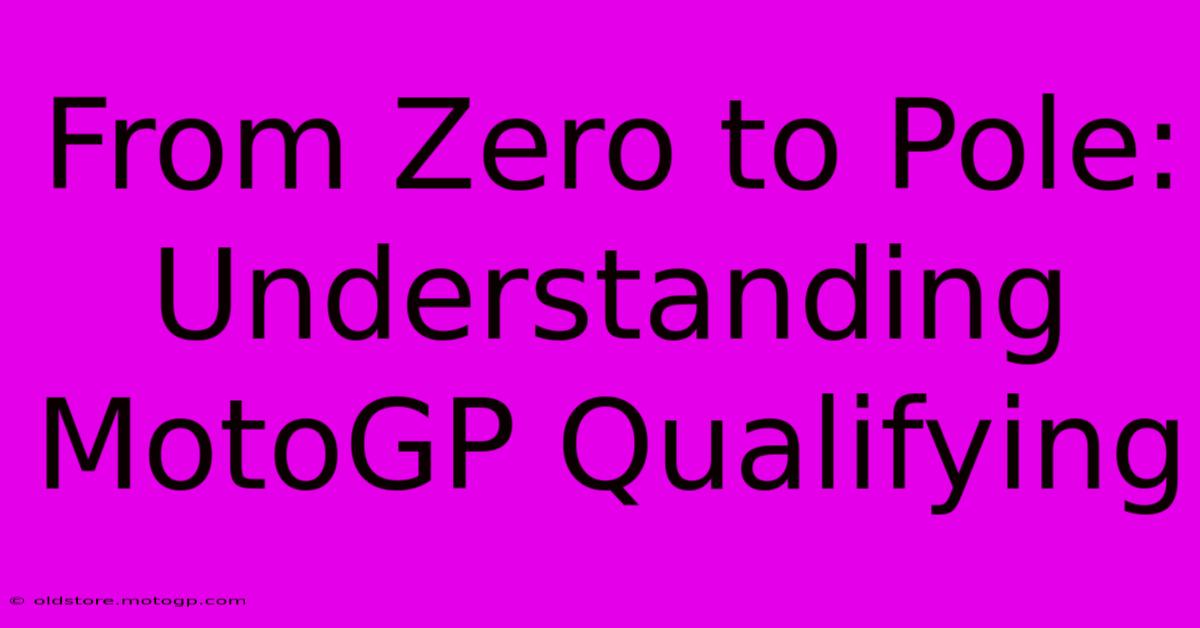From Zero To Pole: Understanding MotoGP Qualifying

Table of Contents
From Zero to Pole: Understanding MotoGP Qualifying
MotoGP, the pinnacle of motorcycle racing, captivates millions with its breathtaking speeds and intense competition. But beyond the race itself lies a crucial element that dictates starting positions and often influences the final outcome: qualifying. Understanding the intricacies of MotoGP qualifying is key to truly appreciating the drama and strategy involved. This comprehensive guide breaks down the process, explaining the formats, the significance of each session, and the factors that contribute to a rider securing pole position.
The Qualifying Format: A Breakdown
MotoGP qualifying isn't a single, straightforward session. Instead, it's a multi-stage process designed to refine the grid and reward performance. The current format generally involves:
Free Practice (FP1, FP2, FP3):
These sessions are crucial, though they don't directly determine qualifying positions. They allow riders to test different bike setups, find the optimal lines, and gather crucial data. FP3 is particularly important, as it often determines who goes directly into Q2. The fastest 10 riders from FP1, FP2, and FP3 combined usually progress directly to Q2.
Qualifying 1 (Q1):
This is the first stage of qualifying and features the riders who didn't make the top 10 in the combined practice times. They have a limited time – typically 15 minutes – to fight for the remaining spots in Q2. The two fastest riders from Q1 then advance. This session is often filled with high stakes and close battles.
Qualifying 2 (Q2):
This is the final and most important qualifying session. The top 10 riders from the combined Free Practice sessions and the two fastest from Q1 compete here. This 15-minute session determines the front row (pole position, second, and third) and the rest of the grid positions for the race. The rider with the fastest lap time in Q2 secures coveted pole position.
The Importance of Pole Position
Starting from pole position offers significant advantages:
- Clean Start: The rider avoids the chaos and jostling that can occur at the beginning of a race.
- Track Position: The rider has the best line into the first corner, allowing them to dictate the pace and potentially control the race from the outset.
- Psychological Advantage: Securing pole position is a huge boost in confidence for both the rider and the team.
Factors Influencing Qualifying Performance
Several factors can significantly impact a rider's qualifying performance:
- Bike Setup: Fine-tuning the bike for a single qualifying lap is crucial. The focus is on achieving maximum speed and stability, sometimes at the cost of race-distance performance.
- Tire Choice: Choosing the right tires for the qualifying session, considering track conditions and temperature, is vital for achieving optimal lap times.
- Rider Skill: Exceptional riding skill and precision are essential to extract the most from the bike during the limited qualifying time. The ability to maintain consistent pace and execute perfect laps under pressure is critical.
- Track Conditions: Changes in track temperature, grip levels, and weather conditions can dramatically affect lap times, making adaptability and strategic decision-making essential.
The Strategy Behind Qualifying
MotoGP qualifying isn't just about raw speed. It involves careful planning and strategy:
- Slipstreaming: Riders often utilize slipstreaming (drafting) to gain a speed advantage, especially on long straights.
- Tire Management: Managing tire wear during qualifying sessions is critical, ensuring that the tires are in optimal condition for the crucial final laps.
- Track Knowledge: Deep knowledge of the track and the optimal racing line is invaluable for achieving the best possible lap times.
Conclusion:
Understanding the complexities of MotoGP qualifying enhances the viewing experience, enabling viewers to appreciate the strategic battles and the high stakes involved. From the intense fight for Q2 to the nail-biting competition for pole position, qualifying is an integral part of the MotoGP spectacle. By understanding the format, the various factors at play, and the strategic considerations, you can fully appreciate the skill, preparation, and tension that this crucial phase of the race involves. So, the next time you watch a MotoGP qualifying session, you'll have a deeper appreciation for the journey "From Zero to Pole."

Thank you for visiting our website wich cover about From Zero To Pole: Understanding MotoGP Qualifying. We hope the information provided has been useful to you. Feel free to contact us if you have any questions or need further assistance. See you next time and dont miss to bookmark.
Featured Posts
-
From Grid To Glory Tnt Sports Moto Gp
Feb 22, 2025
-
Speed Moto Gp The History Of Moto Gp
Feb 22, 2025
-
From The Track To Your Closet Cota F1 Merch
Feb 22, 2025
-
Elevate Your Ride With A Moto Gp Helmet
Feb 22, 2025
-
Austin Gp 2025 Witness Greatness
Feb 22, 2025
